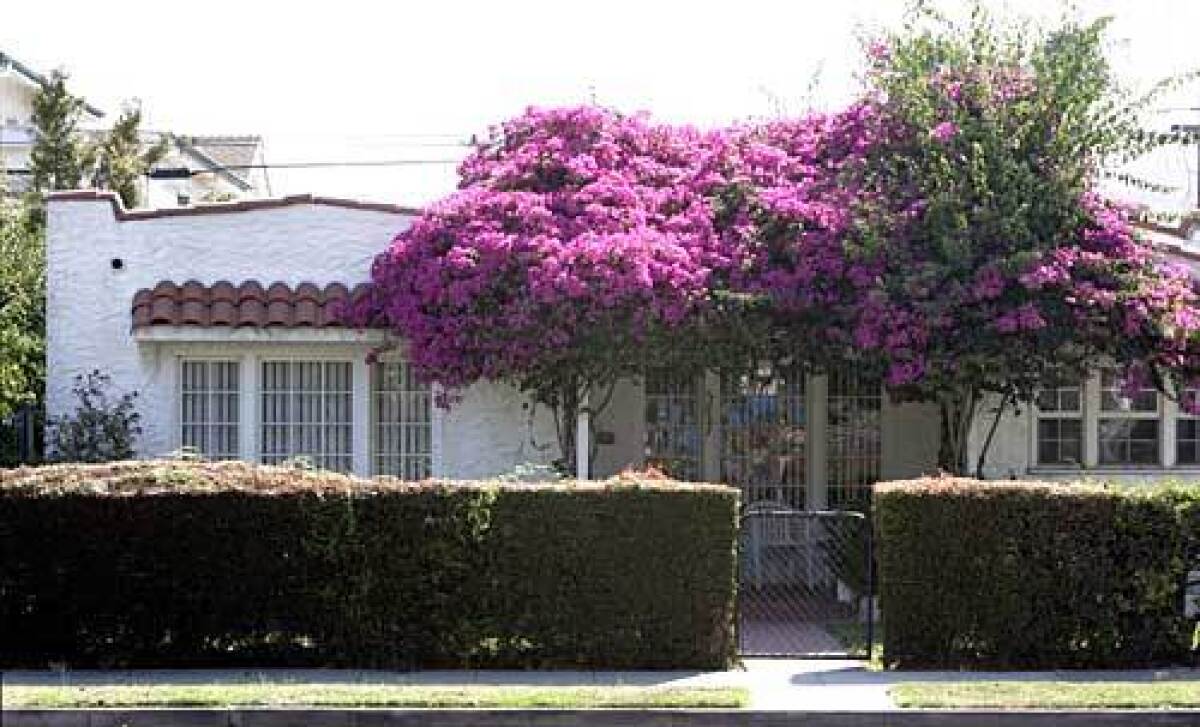Freeway close, family-friendly

Why live in Palms, the community sandwiched among Cheviot Hills, Mar Vista, Culver City and West Los Angeles? Many would say it’s because of the convenience factor.
Beginnings
Developers Joseph Curtis, E.H. Sweetser and C.J. Harrison came along in 1886 and saw the triangular tract known as “The Palms” — bounded by Manning Avenue on the north, Washington Boulevard on the southeast and Overland Avenue on the southwest — as a choice location for home construction. The houses developed were mostly small, two-bedroom cottages. Optimism for a bright future was spurred by development plans for La Ballona Creek. The Ballona Harbor and Improvement Co. planned a major harbor at its mouth “to float the fleets of the world.”
Drawing card
The Ballona Harbor never developed, but Palms did. Like other freeway-close neighborhoods, access is the draw for many who choose to live here. Nearby on-ramps to the 10 and 405 freeways provide commuting options in all four directions.
Insider’s view
Palms evolved from a quaint single-family neighborhood in the 1920s to a center for multifamily-home development in the 1960s. Palms today is again undergoing transformation as new construction and condominium projects slowly replace apartments.“Between Overland and Mentone Avenue, Rose Avenue was once lined with little homes,” commented longtime resident Tom Figus as he walked Princess, his Chihuahua, along Rose. A 40-year resident of the area, Figus has watched the small houses “slowly disappear.”
“It’s still a friendly neighborhood,” Figus said, “there are just more people in it.”
Jennifer Thompson was born and raised on Tilden Avenue at Rose Avenue in the late 1960s. “We loved our neighborhood,” she said, “riding our bikes to the local burger joint and hanging out at the park.” Her husband, Mark, was also raised in the area.
Has the neighborhood changed? “The neighborhood feeling is even tighter-knit than when we were kids,” Jennifer said. “It’s a great feeling to drop the twins off at Grandma’s on Tilden and feel safe and at home.”
According to the 2000 census, 46% of Palms residents are families with children.
Palms is divided into two main sections, with single-family homes primarily west of Overland Avenue making up a neighborhood of tree-lined streets. Residents include UCLA students as well as the long-retired.
Stock report
Few single-family homes remain in the original Palms area, and those that do were built in the late 1920s to ‘30s. But those homes are valuable. One two-bedroom, one-bath home on a 5,271-square-foot lot on Rose Avenue was built in 1939 and has 1,015 square feet of space. It is listed at $849,000. Condominium prices range from $315,000 for a one-bedroom, 849-square-foot unit originally built as an apartment in 1961 to a 1990 property with 1,359 square feet, two bedrooms and three baths for $579,000.
In the newer Westside Village neighborhood of Palms, renovated homes command top prices, such as $1.5 million for a four-bedroom, four-bath home. For starter homes, a cozy 1926 two-bedroom cottage of 1,024 square feet is listed for $689,000.
The area east of Overland Avenue, with the adjacent 10 Freeway, is more urban and gritty, although mid-priced condominiums have been slowly replacing the apartment buildings during the last decade. The new, higher-priced properties, which include trees and landscaping, lend a bit of softness to the area.
Report card
Palms is part of the Los Angeles Unified School District. Four elementary schools are available. The 2004 Academic Performance Index scores were 707 out of a possible 1,000 for Palms Elementary, 720 for Charnock Road Elementary and 912 for Clover Avenue Elementary. Scores for the new Pacifica Charter School, an alternative public school for grades 1-8, have not yet been released.
Students at Palms Middle School scored 766 on the 2004 index; Hamilton Senior High School, 640.
Historical values
Residential resales:
Year...Median price
1990...$339,000
1995...$220,000
2000...$365,000
2004...$655,000
2005...$775,000*
*Year to date
Sources: La Jolla-based DataQuick Information Systems; California Department of Education, api.cde.ca.gov; https://www.palmsvillagesun.info ; https://www.palms-california.us ; https://www.themls.com ; David I. Worsfold, Palms
historian.
More to Read
Sign up for Essential California
The most important California stories and recommendations in your inbox every morning.
You may occasionally receive promotional content from the Los Angeles Times.






